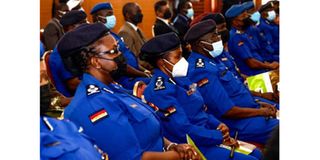Why Kenya Police needs gender audit, mainstreaming

Police officers. The Kenya Police Service needs gender audit and mainstreaming.
What you need to know:
- Kenya has never had a female head of police.
- It would be critical to include gender training in the pre-service courses that all officers go through, and in-service programmes.
When the National Police Service Commission presented its proposals to the task-force on police reforms chaired by retired Chief Justice David Maraga, it suggested that police women be given Sh30,000 maternity dress allowance per pregnancy.
This suggests that the normal uniforms do not fit during pregnancy and that pregnant police officers go to work in civilian clothes or incur personal expenses to make fitting attire. Whatever the case, the proposal raises the issue of gender mainstreaming in the police service.
Let’s start with are numbers. It is obvious that the service is dominated by men in all ranks. This is a historical problem based on the stereotype that security duties are men’s traditional roles. It is also informed by pregnancy, used to justify preclusion of potential female officers from going through the rigorous recruitment exercises for fear that this endangers them and the unborn babies.
Legitimate as this is, it gives men automatic advantage. Which brings to mind the constitutional principle that no more than two-thirds of appointive positions should be occupied by one gender. What target and strategies does the service have in place to comply?
Kenya has never had a female head of police. Thus, a requirement was created that when the Inspector-General is a man, the deputy must be a woman, and vice versa. This would have created a clear pathway for women to dream of eventually ascending the top position. But this dream was crushed when the first female Deputy Inspector General, Grace Kaindi, appointed in January 2013, was hounded out of office. With this, the glass ceiling was firmly restored in the service.
Services
Other issues come to mind about a gender-responsive police service. For instance, are there adequate segregated and properly equipped sanitation facilities for policewomen in the training college and work stations? Are women given the same opportunities in all police operations or are they sidelined during “tough” ones?
Do they benefit from similar career prospects as their male counterparts or are there silent policies that marginalise them? To what extent is the work place free from sexual harassment and abuse of power? What measures are in place to prevent and respond to the vice? How safe are those who report or do they face retaliatory demotions, transfers and other punitive actions to silence them? How many cases have ever been reported and how were they dealt with?
There is also the matter of home-work balance. Because of the traditional gender division of labour, it is women who bear the brunt of combining domestic and professional work. This affects their career progression as they sacrifice or delay the same for the sake of their families.
Men hardly do the same. Home-work balance includes baby care centres in workplaces, flexible work arrangements, and compliance with the mandated 90 days of maternity and 14 of paternity leave without prejudice to annual leave as stipulated in the Employment Act.
It would also be critical to include gender training in the pre-service courses that all officers go through, and in-service programs, handled by competent gender experts. Such an initiative was mooted by the Federation of Women Lawyers in the 1990s.
Calming effect
During training for the Kenya Association of Women in Policing by UN Women in 2014, the then chair of the association claimed that gender had been integrated in the police training curriculum as a result of its advocacy. If this is so, it is certainly laudable and needs to be strengthened and sustained.
The association was formed in 2012 to promote gender-sensitive police reforms, champion the rights of women and enhance professional growth of female officers within the service. One of its focus areas was an increase in the number of women in the police, an ambition that has both intrinsic and practical value.
The United Nations avers that such increases enhance police rapport with the public, create a calming effect on male counterparts and improve the community orientation of policing. They also inspire other “women and girls to advocate for their own rights and pursue careers in law enforcement”.
Policare
To its credit, the police service has a directorate of community policing, children and gender. Of late is the establishment of Policare, an initiative to provide a one-stop centre for services needed by survivors of gender-based violence. In collaboration with civil society, it also established gender desks for reporting of relevant cases.
However, studies show that these desks are bedevilled by under-staffing, poor facilities and transfers, hence loss of momentum. This means they should be monitored and evaluated rigorously to identify and address the existing weakness.
In all, making the service more gender-responsive would require a comprehensive gender audit followed by a mainstreaming strategy.
Dr Miruka is an international gender and development consultant and scholar. [email protected]




